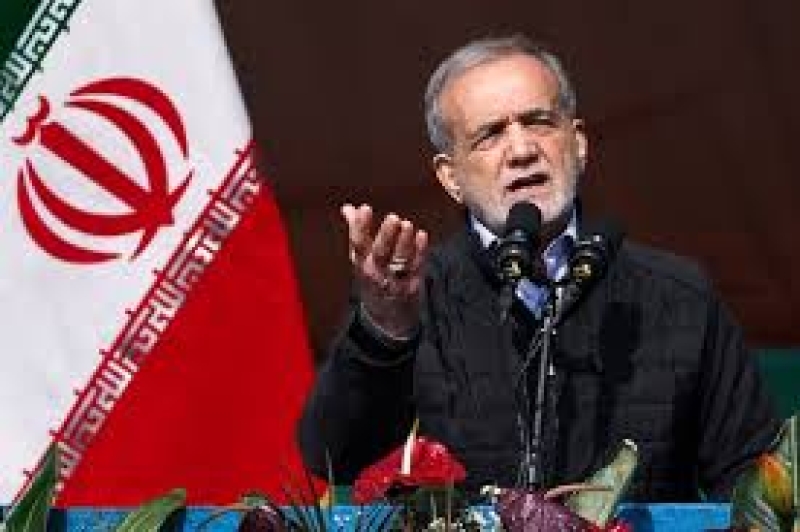- US Issues Travel Alert for Bangladesh Ahead of Election |
- Air ambulance carrying bullet-hit Hadi flies for Singapore |
- Can Dhaka’s arms recovery drive ensure peaceful polls? |
- ‘Unhealthy’ air quality recorded in Dhaka Monday morning |
- BD peacekeepers' deaths: UN chief calls Dr. Yunus, offers condolence |
Iran Rejects Direct Talks with US Amid Escalating Tensions

Iran has firmly rejected the prospect of direct talks with the United States, despite a recent letter from U.S. President Donald Trump aimed at reviving negotiations over Tehran's rapidly advancing nuclear program. The response from Iran highlights the deepening tensions between the two nations, which have been fraught since the 1979 Islamic Revolution.
While Iran has dismissed direct negotiations, it has left the door open for indirect discussions. However, diplomatic efforts in this area have stalled ever since Trump unilaterally withdrew the U.S. from the 2015 nuclear agreement during his first term, intensifying sanctions and exacerbating the strain on relations.
Trump has repeatedly threatened new sanctions as part of his "maximum pressure" campaign on Iran and has suggested that military action against Tehran remains a possibility, though he maintains that a new agreement is still achievable.
In response to these threats, Iran’s 85-year-old Supreme Leader Ayatollah Ali Khamenei warned that any military aggression would be met with a powerful retaliation.
Below is an overview of the latest developments in the diplomatic standoff, Iran’s nuclear ambitions, and the longstanding tensions between Tehran and Washington.
Why Did Trump Write the Letter?
On March 5, 2025, President Trump sent a letter to Khamenei, urging Iran to return to negotiations over its nuclear program. Trump confirmed the correspondence the following day, stating, "I’ve written them a letter saying, 'I hope you’re going to negotiate because if we have to go in militarily, it’s going to be a terrible thing.'" Trump's administration has sought to pressure Iran into talks while simultaneously ratcheting up sanctions and implying the possibility of military strikes targeting Iran’s nuclear facilities.
This letter follows a similar tactic Trump used during his first term with North Korea, where he exchanged letters with Kim Jong Un, eventually leading to face-to-face meetings, though no concrete agreements were reached to curtail North Korea's nuclear and missile programs.
Iran's Response
Iran’s leadership has been unequivocal in rejecting direct negotiations with the U.S. In a televised Cabinet meeting on Sunday, Iranian President Masoud Pezeshkian stated, “We don’t avoid talks; it’s the breach of promises that has caused issues for us so far. They must prove they can build trust.”
On Monday, Ayatollah Khamenei responded to Trump’s renewed threats of military action, asserting, "They threaten to commit acts of mischief, but we are not entirely certain that such actions will take place. We do not consider it highly likely that trouble will come from the outside. However, if it does, they will undoubtedly face a strong retaliatory strike.”
Iran's Foreign Ministry spokesperson, Esmail Baghaei, further condemned Trump’s rhetoric, calling it a “shocking affront to the very essence of International Peace and Security.” He added, “Violence breeds violence, peace begets peace. The US can choose its course, but it must be prepared to face the consequences.”
Why Does Iran’s Nuclear Program Worry the West?
While Iran maintains that its nuclear program is intended for peaceful purposes, many in the West are concerned about the potential for Iran to develop nuclear weapons. Iran has significantly advanced its nuclear capabilities, enriching uranium to nearly weapons-grade levels of 60%, making it the only non-nuclear weapons state to do so.
Under the 2015 nuclear deal, Iran was restricted to enriching uranium to just 3.67% purity and maintaining a stockpile of no more than 300 kilograms (661 pounds). However, the most recent report from the International Atomic Energy Agency (IAEA) reveals that Iran's stockpile has surged to over 8,294 kilograms (18,286 pounds), with a portion enriched to 60%.
While U.S. intelligence agencies currently assess that Iran has not yet begun a formal weapons program, the country’s actions could position it to develop a nuclear weapon if it chooses to do so.
Why Are Relations So Strained Between Iran and the U.S.?
U.S.-Iran relations were once much closer, particularly during the reign of Shah Mohammad Reza Pahlavi, who maintained strong ties with Washington. The U.S. supported Iran militarily and provided technical assistance for intelligence operations, including the CIA-backed coup in 1953 that bolstered the shah’s regime.
However, in 1979, the Islamic Revolution led by Ayatollah Ruhollah Khomeini toppled the shah, establishing the theocratic government that remains in power today. Later that year, Iranian militants seized the U.S. Embassy in Tehran, leading to a 444-day hostage crisis and the rupture of diplomatic relations.
The U.S. and Iran were on opposing sides during the Iran-Iraq War in the 1980s, with the U.S. supporting Saddam Hussein. The conflict saw military skirmishes between the two nations, including a U.S. attack on Iranian vessels in the Persian Gulf and the downing of an Iranian civilian airliner by the U.S. Navy.
Relations fluctuated in the decades following the war, reaching a temporary high point in 2015 with the signing of the Joint Comprehensive Plan of Action (JCPOA), or the Iran nuclear deal. However, Trump’s decision to unilaterally withdraw from the agreement in 2018 reignited tensions, with both sides engaging in a war of words and escalating sanctions that have left the region on edge ever since.

